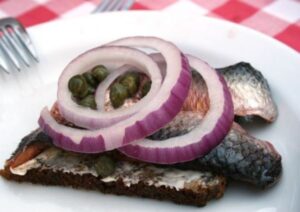Move Over, Mediterranean Diet: Sustainable Scandinavian Fare May be Healthier

You’re probably already familiar with the Mediterranean diet, the heart-healthy wave of concentrating more on fish, fresh fruits and vegetables and olive oil. Maybe you’ve even got a few favorites in your repertoire that adhere to this delicious diet. But there’s a new regional diet that’s coming to a table near you… one that’s influenced not by southern Europe, but by the north.
What’s the Scandinavian Diet?
According to a study published in theEuropeanJournal of Internal Medicine,the Scandinavian diet, rich in canola or rapeseed oil, berries, root vegetables and fish, could be a new healthy alternative for people with metabolic syndrome, a precursor to diabetes running rampant in the US… or even those just looking to increase general heart health through diet.
Similar to the Mediterannean Diet, this Scandinavian diet, as defined by the study, includes herring, salmon, mackerel, rapeseed oil, currants, bilberries, strawberries, whole grains and root vegetables. The diet was designed based on local foods regularly or traditionally consumed or found in Nordic countries. Those who ate this diet for between 18 and 24 weeks saw a marked improvement in cholesterol levels, according to the study, thus posing the question: could this be the next big thing?
A Sustainable Adaptation
The Scandinavian diet was created with local Scandinavian produce in mind. In order to adapt this diet locally and sustainably in the States, several changes must be made.
First off, it’s important to be very careful when selecting the rapeseed or canola oil used. Most canola oil in the US comes from GMO seeds, though demand has opened up the market for GMO-free canola oils. Until these GMO-free versions become more widely available, be sure to check and verify that oils you purchase are indeed GMO-free.
Another sustainability issue comes from the fish portion of the diet. While fish is an important healthy addition to diets like the Mediterannean diet and Scandinavian diet, it’s just as important to seek out sustainably fished seafood. Be sure to buy sustainable wild salmon, and now that mackerel is no longer sustainable, choose other fatty fish like herring and sardines instead.
Seasonally, you can vary the root vegetable and berry elements of the diet to accomodate what is locally available near you. European bilberries can easily be replaced with antioxidant-rich American blueberries.
Recipe Ideas
Once you’ve gotten on board with this sustainable version of the new Scandinavian diet, the world is your oyster! Here are just a few recipe ideas to get you started:
- Grilled salmon, potatoes and asparagus salad
- Sustainable salmon burger
- Pasta with sardines
- Smørrebrøds
- Pickled herring
- Billions of blueberries pie

